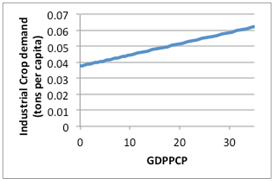International Futures Help System
Industrial Demand for Crops
Industrial demand for crops (IndDem) is initially estimated for the first year in the pre-processor. It is determined, arbitrarily, as one tenth of crop supply, which equals post loss crop production plus imports minus exports.
![]()
It can then be decreased (increased) if the initial estimates of crop demand for food are considered too low (high).
In the first year, two values related to industrial demand for crops (now called INDEM) are calculated. The first of these is a multiplicative shift factor (INDEMK), which is calculated as the ratio of relates actual to predicted industrial demand for crops. The predicted value is given by a function that relates per capita industrial demand to GDP per capita, which is shown below. [1] This multiplicative shift factor remains constant over time.

The same function is used to calculate an expected demand for the next year (eindem). The predicted value from the function is computed using the expected level of GDP per capita (egdppcp); this value is multiplied by the expected population (epop) and the multiplicative shift factor (INDEMK) to calculate the expected demand. This expected demand is used in conjunction with the expected demands for crops for feed and crops for food to determine the initial target growth rate in yield (tgryli) discussed in the section on crop production above.
In the forecast years, the initial value of industrial demand for crops is also estimated using the table function above to get a predicted value for industrial demand per capita, which is then multiplied by population (POP) and the multiplicative shift factor (INDEMK). At this point, a region-specific multiplier ( agdemmf=1 ) can either increase or decrease the initial estimate of INDEM.
The first adjustment to INDEM is related to the world energy price (WEP) and reflects the use of crops for fuel production. Specifically, as the world energy price increases relative to the price in the first year, the industrial demand for crops increases.

where
WEP is world energy price
FoodforFuel is the elasticity of industrial use of crops to world energy prices. It starts at a value given by the global parameter elagind , and declines to a value of 0 over 50 years.
The second adjustment relates to the world crop price (WAPf=1); as this increases relative to the price in the first year, industrial demand for crops declines.

where
WAP is world crop price
elascd is a global parameter specifying the elasticity of crop demand to global food prices
A third adjustment is based on an assumed cap on per capita industrial demand for crops (IndemCapperPop —hard coded, declines from 0.17 to 0.12 over 50 years). Specifically, INDEM is not allowed to exceed IndemCapperPop * POP.
Finally, INDEM can be reduced if the sum of expenditures on food crops at world prices (FDEM*WAPf=1) and meat (AGDEMf=2*WAPf=2) exceeds 85 percent of household consumption expenditures as calculated in the economic model.
[1] Equation is INDEM = 0.0376 + 0.000704 * GDPPCP
 International Futures at the Pardee Center
International Futures at the Pardee Center